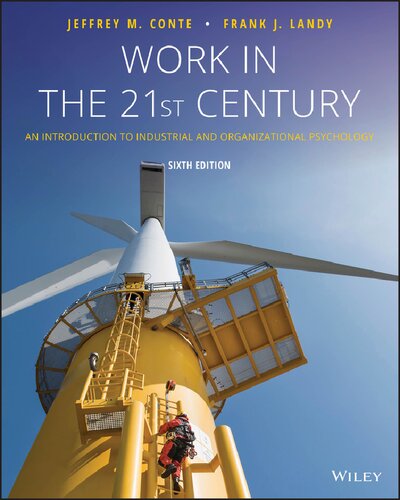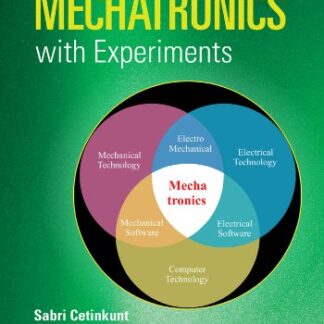Description
Work in the 21st Century: An Introduction to Industrial and Organizational Psychology 6th Edition by Jeffrey M. Conte, ISBN-13: 978-1119493419
[PDF eBook eTextbook]
- Publisher: Wiley; 6th edition (December 21, 2018)
- Language: English
- 704 pages
- ISBN-10: 1119493412
- ISBN-13: 978-1119493419
Now in its sixth edition, Work in the 21st Century: An Introduction to Industrial and Organizational Psychology by Jeffrey M. Conte and Frank J. Landy is the most current and engaging text for the industrial and organizational (I-O) psychology course. The text ties together themes and topics such as diversity, cognitive and physical abilities, personality, emotional intelligence, technology, multicultural dynamics, and evidence-based I-O psychology in a way that explores the rich and intriguing nature of the modern workplace. The sixth edition retains the 14-chapter format and the E-Text maintains a colorful design that brings I-O psychology to life, especially with the use of newsworthy color photographs.
Table of Contents:
Preface
PART 1: FUNDAMENTALS
Chapter 1: What Is Industrial and Organizational Psychology?
Module 1.1 The Importance of I-O Psychology
The Importance of Work in People’s Lives
What Is I-O Psychology?
How This Course Can Help You
The Importance of Understanding the Younger Worker
Module 1.2 The Past, Present, and Future of I-O Psychology
The Past: A Brief History of I-O Psychology
The Present: The Demographics of I-O Psychologists
The Future: The Challenges to I-O Psychology in the 21st Century
A Personal View of the Future: Preparing for a Career in I-O Psychology
Module 1.3 Multicultural and Cross-Cultural Issues in I-O Psychology
The Multicultural Nature of Life in the 21st Century
Theories of Cultural Influence
Module 1.4 The Organization of This Book
Themes
Parts
Resources
Chapter 2: Research Methods and Statistics in I-O Psychology
Module 2.1 Science and Research
What Is Science?
The Role of Science in Society
Why Do I-O Psychologists Engage in Research?
Research Design
Methods of Data Collection
Generalizability and Control in Research
Ethical Behavior in I-O Psychology
Module 2.2 Data Analysis
Descriptive and Inferential Statistics
Correlation and Regression
Correlation and Causation
Big Data
Meta-Analysis
Micro-, Macro-, and Meso-Research
Module 2.3 Interpretation through Reliability and Validity
Reliability
Validity
PART 2: INDUSTRIAL PSYCHOLOGY
Chapter 3: Individual Differences and Assessment
Module 3.1 An Introduction to Individual Differences
Some Background
Differential Psychology, Psychometrics, and I-O Psychology
Identifying Individual Differences
Varieties of Individual Differences
Module 3.2 Human Attributes
Abilities
Cognitive Abilities
Physical, Sensory, and Psychomotor Abilities
Personality and Work Behavior
Skills
Knowledge
Competencies
Emotional Intelligence
Module 3.3 Foundations of Assessment
The Past and the Present of Testing
What Is a Test?
Administrative Test Categories
Testing and Culture
Module 3.4 Assessment Procedures
Assessment Content versus Process
Assessment Procedures: Content
Tests of Physical Abilities
Personality
Emotional Intelligence
Individual Assessment
Interviews
Assessment Centers
Work Samples and Situational Judgment Tests
Module 3.5 Special Topics in Assessment
Incremental Validity Measuring Implicit Variables at Work Biographical Data
Grades and Letters of Recommendation
Minimum Qualifications
Controversial Assessment Practices: Graphology and the Polygraph
Drug and Alcohol Testing
Computer-Based and Internet Assessment
Chapter 4: Job Analysis and Performance
Module 4.1 A Basic Model of Performance
Campbell’s Model of Job Performance
Criterion Deficiency and Contamination
Module 4.2 Extensions of the Basic Performance Model
Task Performance versus Organizational Citizenship Behavior
The Dark Side of Performance: Counterproductive Work Behaviors
Adaptive Performance
A Brief Recap
Expert Performance
Types of Performance Measures
Module 4.3 Job Analysis: Fundamental Properties and Practices
The Uses of Job Analysis Information
Types of Job Analysis
How Job Analysis Is Done
Work Analysis
Module 4.4 Job Analysis: Newer Developments
Electronic Performance Monitoring as Part of a Job Analysis
Cognitive Task Analysis
Personality-Based Job Analysis
A Summary of the Job Analysis Process
Computer-Based Job Analysis
O*NET
Competency Modeling
Module 4.5 Job Evaluation and the Law
Job Evaluation
The Concept of Comparable Worth
Job Analysis and Employment Litigation
Chapter 5: Performance Measurement
Module 5.1 Basic Concepts in Performance Measurement
Uses for Performance Information
Module 5.2 Performance Rating—Substance
Theories of Performance Rating
Focus on Performance Ratings
Rating Formats
Employee Comparison Methods
Module 5.3 Performance Rating—Process
Rating Sources
Rating Distortions
Rater Training
Reliability and Validity of Performance Ratings
Module 5.4 The Social and Legal Context of Performance Evaluation
The Motivation to Rate
Goal Conflict
Performance Feedback
Performance Evaluation and Culture
Performance Evaluation and the Law
Chapter 6: Staffing Decisions
Module 6.1 Conceptual Issues in Staffing
An Introduction to the Staffing Process
The Impact of Staffing Practices on Firm Performance
Stakeholders in the Staffing Process
Staffing from the International Perspective
Module 6.2 Evaluation of Staffing Outcomes
Validity
Utility
Fairness
Module 6.3 Practical Issues in Staffing
A Staffing Model
Combining Information
Deselection
Number of Decisions to Be Made
21st-Century Staffing
Module 6.4 Legal Issues in Staffing Decisions
Charges of Employment Discrimination
Employment Discrimination outside of the United States
Theories of Discrimination
Chapter 7: Training and Development
Module 7.1 Foundations of Training and Learning
Training, Learning, and Performance
Training Needs Analysis
The Learning Process in Training
Learning Organizations
Module 7.2 Content and Methods of Training
Training Methods
Training “Critical Thinking”
Transfer of Training
Module 7.3 Evaluating Training Programs
Training Evaluation
Training Criteria
Utility Analysis
Training Evaluation Designs
Equal Employment Opportunity Issues in Training
Module 7.4 Specialized Training Programs
Management and Leadership Development
Sexual Harassment Awareness Training
Ethics Training
Cross-Cultural Training
PART 3: ORGANIZATIONAL PSYCHOLOGY
Chapter 8: The Motivation to Work
Module 8.1 An Introduction to Motivation
The Central Position of Motivation in Psychology
A Brief History of Motivation Theory in I-O Psychology
Metaphors for Motivation
The Meaning and Importance of Motivation in the Workplace
Module 8.2 Classic Approaches to Motivational Theories
Person-as-Machine Theories
Person-as-Scientist Theories
Module 8.3 Modern Approaches to Work Motivation
Person-as-Intentional Approaches
The Concept of Self-Efficacy in Modern Motivation Theory
Common Themes in Modern Motivation Approaches
A New Motivational Topic: The Entrepreneur
Module 8.4 Practical Issues in Motivation
Can Motivation Be Measured?
Cross-Cultural Issues in Motivation Generational Differences and Work Motivation
Motivational Interventions
Chapter 9: Attitudes, Emotions, and Work
Module 9.1 Work Attitudes
The Experience of Emotion at Work
Job Satisfaction: Some History
The Measurement of Job Satisfaction
The Concept of Commitment
Organizational Identification
Employee Engagement
Module 9.2 Moods, Emotions, Attitudes, and Behavior
Is Everybody Happy? Does It Matter If They Are?
Satisfaction versus Mood versus Emotion Withdrawal Behaviors
Module 9.3 Special Topics Related to Attitudes and Emotions
Job Loss
Telecommuting
Work–Family Balance
Psychological Contracts
Job Embeddedness
Job Crafting
Work-Related Attitudes and Emotions from a Cross-Cultural Perspective
Chapter 10: Stress and Worker Well-Being
Module 10.1 The Problem of Stress
Studying Workplace Stress
What Is a Stressor?
Common Stressors at Work
Consequences of Stress
Work Schedules
Module 10.2 Theories of Stress
Demand–Control Model
Person–Environment Fit Model
Individual Differences in Resistance to Stress
Module 10.3 Reducing and Managing Stress
Primary Prevention Strategies
Secondary Prevention Strategies
Tertiary Prevention Strategies
Summary of Stress Intervention Strategies
Module 10.4 Violence at Work
Stress and Workplace Violence
The “Typical” Violent Worker
Theories of Workplace Violence
A Special Type of Violence: Bullying
What Can We Conclude about Workplace Violence?
Chapter 11: Fairness, Justice, and Diversity in the Workplace
Module 11.1 Justice and Fairness
The Concept of Justice
Justice, Fairness, and Trust
Approaches to Organizational Justice
Module 11.2 The Practical Implications of Justice Perceptions
Performance Evaluation
Applicant Reactions to Selection Procedures
Affirmative Action
Module 11.3 Diversity
What Does Diversity Mean?
The Dynamics of Diversity
Chapter 12: Leadership in Organizations
Module 12.1 The Concept of Leadership
Some Conceptual Distinctions
The Problem of Defining Leadership Outcomes
Negative Leadership Outcomes: The Destructive Leader
Leader versus Manager or Supervisor
Leader Development versus Leadership Development
The Motivation to Lead
Module 12.2 Traditional Theories of Leadership
The “Great Man” Theories
The Trait Approach
The Power Approach to Leadership
The Behavioral Approach
The University of Michigan Studies
The Contingency Approach
The Consequences of Participation: The Vroom–Yetton Model
Module 12.3 New Approaches to Leadership
Leader–Member Exchange (LMX)
Transformational Leadership
Authentic Leadership
The Charismatic Leader
Module 12.4 Emerging Topics and Challenges in Leadership Research
Leadership in a Changing Workplace
Male and Female Leaders: Are They Different?
Personality and Leadership
Leadership and Neuroscience
Cross-Cultural Studies of Leadership
Leadership in a Diverse Environment
Guidelines for Effective Leadership
Chapter 13: Teams in Organizations
Module 13.1 Types of Teams
Groups and Teams: Definitions
Types of Teams
Module 13.2 Input-Process-Output Model of Team Effectiveness
Team Inputs
Team Processes
Team Outputs
Module 13.3 Special Issues in Teams
Team Appraisal and Feedback
Team Roles
Team Development
Team Training
Cultural Issues in Teams
Chapter 14: Organizational Theory, Dynamics, and Change
Module 14.1 Conceptual and Theoretical Foundations of Organizations
Organizations and People
Organization as Integration
Theories of Organization
Module 14.2 Social Dynamics of Organizations
Climate and Culture
Climate and Culture from the Multicultural Perspective
An Application of Culture and Climate: Safety
Socialization and the Concept of Person-Organization (P-O) and Person-Job (P-J) Fit
Module 14.3 Organizational Development and Change
Organizational Change
Examples of Large-Scale Organizational Change Initiatives
Emerging Commonalities among Organizational Interventions
Glossary
References
Name Index
Subject Index
What makes us different?
• Instant Download
• Always Competitive Pricing
• 100% Privacy
• FREE Sample Available
• 24-7 LIVE Customer Support




